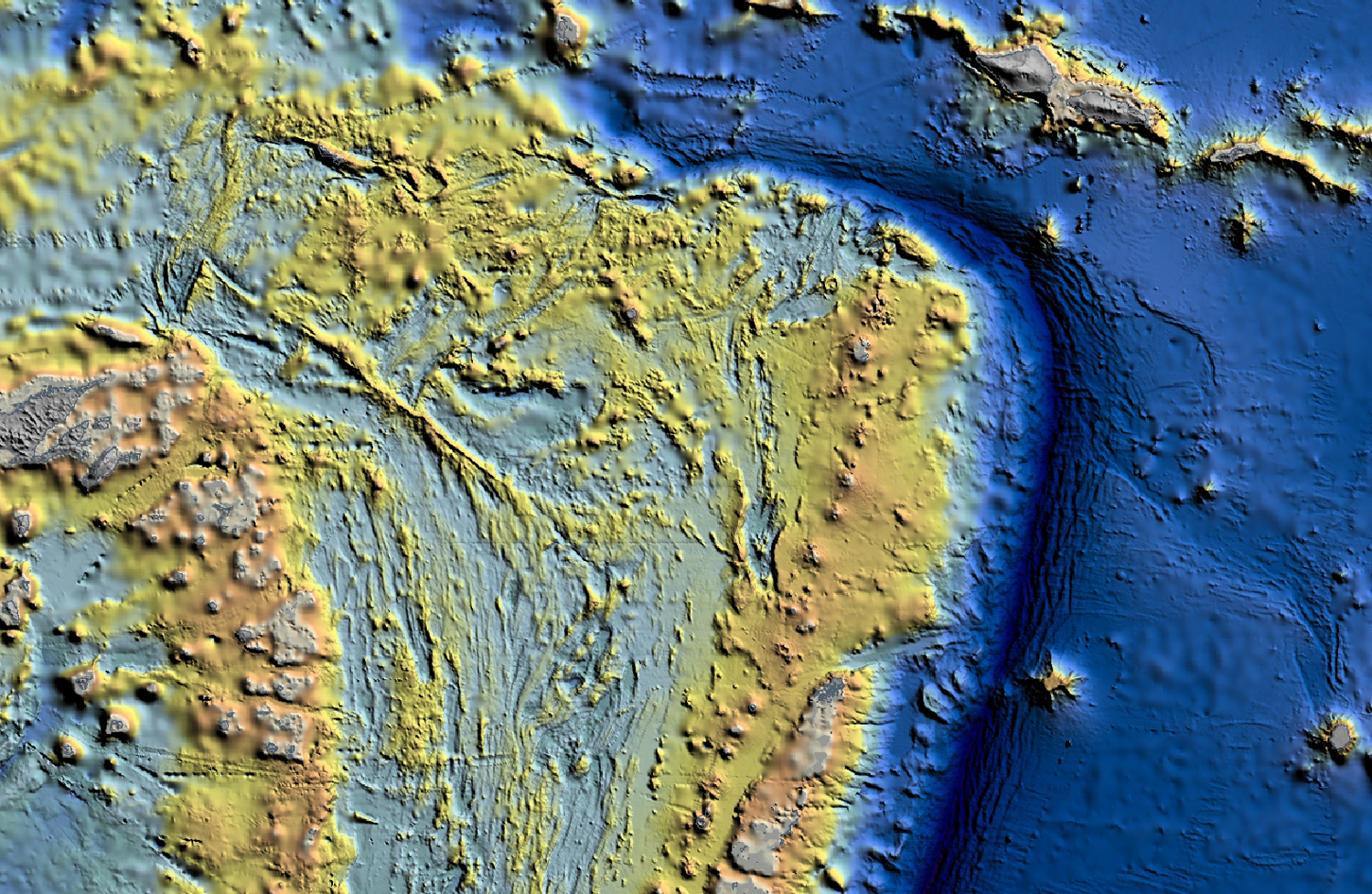Metal Earth Project: Modern Ocean
Crust Project (Metal Oceans)
Project Information
Project Title:Modern Ocean Crust Project (Metal Oceans)
Research Location:Indo-Australian margin (Lau Basin, North Fiji-New Hebrides, and Eastern PNG)
Project Status:Active
Contact:Professor, Ottawa University.
|
Research Team:Margaret Stewart, PDF, University of Ottawa* Alan Baxter, Research Associate, University of Ottawa* Melissa Anderson, RA/PDF, University of Ottawa* Justin Emberley, GIS Technician, University of Ottawa* Kaitlyn Breker, GIS Technician, University of Ottawa* Marc Fassbender, PhD student, University of Ottawa* Joel Ryan, BSc student, University of Ottawa*
Philipp Brandl, PDF, GEOMAR-Helmholtz Centre for Ocean Research Rebecca Lintzel-Mensing, MSc student, Martin Luther Univ − GEOMAR Chantal Norris-Julseth, MSc student, University of Toronto Meike Klischies, PhD student, University of Kiel − GEOMAR Sebastian Graber, PhD student, University of Kiel − GEOMAR Anna Krätschell, GIS Technician, GEOMAR
*indicates ME-funded, all others partner-funded |
Academic Collaborators:
- Harold Gibson, Professor, Harquail School of Earth Sciences, Laurentian University
- Thomas Monecke, Colorado School of Mines, Boulder, USA
- Patrick Mercier-Langevin, Natural Resources Canada
- John Jamieson, Memorial University of Newfoundland
- Sven Petersen, Helmholtz Centre for Ocean Research−GEOMAR
- Karsten Haase, GeoZentrum Nordbayern, FAU Erlangen-Nürnberg
- Christoph Beier, GeoZentrum Nordbayern, FAU Erlangen-Nürnberg
- Heidrun Kopp, Helmholtz Centre for Ocean Research−GEOMAR
- Colin Devey, Helmholtz Centre for Ocean Research−GEOMAR
- Kaj Hoernle, Helmholtz Centre for Ocean Research−GEOMAR
- Nico Augustin, Helmholtz Centre for Ocean Research−GEOMAR
- Marion Jegen-Kulscar, Helmholtz Centre Ocean Research−GEOMAR
- Florian Schmid, Helmholtz Centre for Ocean Research−GEOMAR
- Michael Schnabel, German Geological Survey (BGR), Hannover
- Ulrich Schwarz-Schampera, BGR, Hannover
- Udo Barckhausen, German Geological Survey BGR, Hannover
- Ingo Heyde, German Geological Survey BGR, Hannover
- Christian Timm, GNS New Zealand, Wellington, New Zealand
- Richard Arculus, Australian National University, Canberra
- Brent McInnes, Curtin University, Perth, Western Australia
- Hans-Hermann Gennerich, University of Bremen
Industry Collaborators:
- John Parianos, Nautilus Minerals
- Tim McConachy, Neptune Minerals
- John McGaughey, Mira Geoscience
- Paulo Ferreira, BearingPoint
Scope of Project:
Metal Oceans is a sub-project of Metal Earth focusing on the comparison of modern ocean crust and its evolution with the structure and composition of greenstone belts. The primary objective is to investigate the relationship between microplate formation and the emergence of magmatic-hydrothermal systems in modern convergent-margin settings to better understand crustal growth and metal endowment. The emphasis is on i) microplate interactions, ii) structural and magmatic evolution of primitive arc and back-arc assemblages, iii) the link to mantle processes and heterogeneity, and iv) the emergence of magmatic-hydrothermal systems, particularly during early stages of arc rifting.
Metal Oceans is aimed at revealing the geodynamic and magmatic complexity at a fine scale (10s to 100 km) in three sub-regions of the Indo-Australian margin (Lau Basin, North Fiji-New Hebrides, and Eastern PNG) which host spectacular concentrations of metals and hydrothermal activity. The complex microplate evolution in these areas is being documented in a series of crustal imaging experiments and mapping projects, directly analogous to the ME transects and exploring processes that may be similar to those that dominated late Archean tectonics.

Figure 1: Bathymetric map of the northern Lau Basin showing its complex geology and structure. (Source: Global Multi-Resolution Topography Data Synthesis).
Anticipated Outcomes:
The major outputs of Metal Oceans by the end of Year 4 will include i) publication of the new Microplate Atlas of the Western Pacific region, with a focus on the Indo-Australian margin, ii) a geophysical and lithogeochemical compilation of the study areas, and iii) quantitative analysis of the geological maps and crustal sections for comparison with ancient greenstone belts. We will also publish the results of the first marine transect in the Lau Basin, including high-resolution seismic, electromagnetic, magnetic, and heat flow data together with volcanic geochemistry and geochronology at a scale that will be directly comparable to the Metal Earth transects. An important outcome of the crustal imaging experiments will be to establish new criteria for recognizing melt- and fluid-ascent pathways at regional scales, how they are organized, and their spatial and temporal link to large magmatic-hydrothermal systems. We expect to be able to identify specific types of microplate boundaries (and possible links to mantle heterogeneities) that connect with translithospheric faults and evolve into major corridors for melt and fluid transport through the crust – fundamental aspects of fertility and mineral endowment in greenstone belts. Details of the research goals relevant to Metal Earth will be presented in the peer-reviewed publications, abstracts, and conference presentations. The project will also train new Canadian (currently 7) and international (6, including one in Canada) researchers in the application of regional geodynamics to mineral exploration (see list of HQP).
Transect Related Documents
Metal Oceans studies modern ocean environments to provide insights to ore deposits in the Superior Craton.
Metal Earth Geohub - Metal Oceans related documents
Highlights in the media:
a) Transect SO-267 of Metal Oceans was highlighted in the media and on web pages in Germany and in Canada, including blogs, weekly reports and interviews:
https://merc.laurentian.ca/news-standard/metal-oceans-research-expedition
https://merc.laurentian.ca/news-standard/modern-ancient-ocean-crust-project
https://merc.laurentian.ca/sites/default/files/metal_oceans_advisory_boa...
https://www.geomar.de/en/research/expeditionen/detail-view/exp/current/3...
https://www.geomar.de/en/news/article/weihnachten-im-westpazifik/
https://www.geomar.de/service/kommunikation/geomar-news-single-aktuell/a...
German News Media:
Wilhelmshaven Zeitung, December 24, seite 54, Birth of a new continent in the deep sea
Kiel Nachtricten, December 12, 2108, seite 24, In search of a new continent
b) Anderson’s PhD thesis on the Relationships Between Tectonics, Volcanism, and Hydrothermal Venting in the New Hebrides and Mariana Back-Arc Basins was nominated by the Faculty of Science at the University of Ottawa for the Best University Thesis Award in 2018-19 (results pending). She will also receive the Léopold Gélinas Award for most outstanding thesis written by a Canadian from the Volcanology and Petrology Division, Geological Association of Canada, to be presented at the May 2019 meeting in Quebec City.



